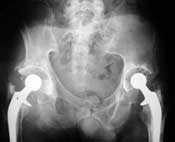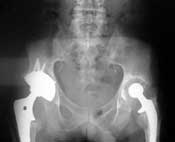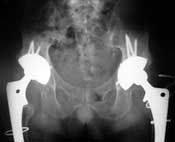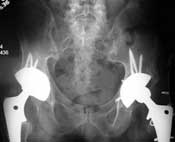Tantalum revision cups stable at two years, even in type 3 defects
No cups loosened, but 5.2% of cups required reoperation. Longer follow-up should reveal the natural course of minor radiolucencies seen.
 WASHINGTON — Some joint reconstruction specialists consider revision acetabular cups made of highly porous tantalum more stable than standard cemented and uncemented ones. They also consider them a good way for their patients to avoid a second revision surgery on the acetabular side of the hip.
WASHINGTON — Some joint reconstruction specialists consider revision acetabular cups made of highly porous tantalum more stable than standard cemented and uncemented ones. They also consider them a good way for their patients to avoid a second revision surgery on the acetabular side of the hip.
To solve the longstanding problem of multiple acetabular revision procedures, surgeons at the Mayo Clinic in Rochester, Minn., used porous tantalum cups in a consecutive series of patients, obtaining encouraging short-term results in these highly challenging situations.
Research on the material has supported very rapid and intensive new bone ingrowth, noted Rodrigo M. Mardones, MD, of Santiago, Chile. “The particular properties of this material showed a high chance of success when revision acetabular surgery is prescribed,” he said.
For the study, surgeons used a porous tantalum revision acetabular cup, fitted with a modular polyethylene liner cemented in place. They followed patients postoperatively for a minimum of two years and evaluated the implant’s clinical and radiographic performance.
The elliptical-shaped cup makes up part of Zimmer’s (Warsaw, Ind.) Trabecular Metal Modular Acetabular System. With a periphery 2 mm larger than the diameter of the bone reamed to implant it, the cup provides an interference fit that improves bone contact and stability, Mardones explained.
Center of rotation studied
From 1999 to 2001, surgeons performed acetabular revisions in 111 consecutive patients (114 components). Follow-up ranged from two to five years. They excluded patients with pelvic discontinuity or infection.
Factors explored in the radiographic analysis of these cases included preoperative acetabular defect classification with the Paprosky system, the cup’s center of rotation according to Ranawat zone, and any presence of radiolucent lines at two years or any other point during the follow-up.
The Paprosky system used relies on acetabular defect assessment done preoperatively and intraoperatively. The system rates a normal acetabulum as type 1, an acetabulum with 70% or more host bone present as type 2 and important bone loss as a type 3 defect. Within each type are subgroups A through C representing increasing degrees of bone loss; subgroup C represents severe bone loss. Half of the acetabula followed (49%) had deficits classified as type 2C, 3 or 3B.
Ten patients died prior to the two-year follow-up, but researchers included their data through the time of death.
|
Insignificant radiolucencies
Implanting the cups was uncomplicated. “Most of the patients required bone grafting, typically autologous or allograft morselized cancellous bone impacted with a reverse reamer,” Mardones said, in presenting these results during the American Academy of Orthopaedic Surgeons 72nd Annual Meeting, here.
Based on radiographic follow-up, 86% of the hips showed no radiolucent lines and 14% had incomplete lines. “Only one patient showed a new radiolucent line and two patients showed progression of the incomplete radiolucent line. These are the patients that might require additional surgery. Most of the patients showed regression, resolution or a stable appearance of the radiolucency seen initially,” he said.
“Cup migration was not seen in any of these hips.” Researchers said 5.2% of cases needed additional revision surgery for instability, hematoma or wire removal. Researchers found 86% of patients attained an anatomical reconstruction with the cup’s center of rotation in Ranawat zone 1.
“Longer follow-up is required to validate this approach; however, these results are encouraging with regard to the use of a porous tantalum in a revision setting in a two- to five-year interval, despite the significant percentage of patients with major acetabular defects,” Mardones said.
For more information:
- Mardones RM, Talac R, Hanssen AD, et al. Use of a porous tantalum revision shell in revision total hip arthroplasty. #277. Presented at the American Academy of Orthopaedic Surgeons 72nd Annual Meeting. Feb. 23-27, 2005. Washington.




